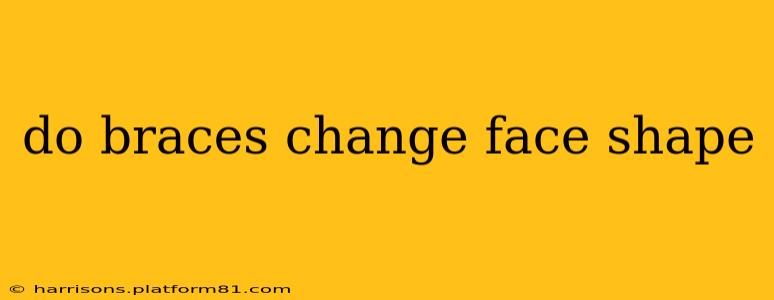Many people wonder if braces can alter their facial structure. The short answer is: yes, braces can subtly change your face shape, but the extent of the change depends on several factors. This comprehensive guide will explore how braces impact facial appearance, addressing common concerns and misconceptions.
How Do Braces Affect Face Shape?
Orthodontic treatment, using braces or aligners, primarily focuses on correcting teeth alignment and bite problems. However, because the position of your teeth is intimately connected to the muscles and bones of your jaw, moving teeth can indirectly influence facial features. The changes are usually subtle and gradual, and often not dramatic.
The most noticeable changes typically occur in the:
- Jawline: Correcting an overbite or underbite can subtly alter the jawline's appearance, making it appear more defined or balanced.
- Cheekbones: Improved tooth alignment can slightly affect the way cheek muscles sit, potentially creating a more prominent or less prominent appearance of the cheekbones.
- Chin: Addressing jaw misalignment can influence the projection of the chin, leading to a perceived change in the overall facial balance.
What Causes These Changes?
The changes are primarily due to:
- Muscle adaptation: As teeth shift, the muscles supporting the face adapt to the new positions. This adaptation can lead to subtle changes in the soft tissues of the face.
- Jawbone remodeling: In some cases, particularly with significant misalignments, the jawbone itself might undergo minor remodeling. This is a slow process, guided by the repositioning of teeth.
- Improved facial symmetry: Correcting crooked teeth and bite problems can lead to better facial symmetry, creating a more harmonious and balanced facial appearance.
Will Braces Make My Face Look Thinner?
This is a frequently asked question. While braces might indirectly contribute to a slimmer appearance by improving facial symmetry and jawline definition, they are not a weight loss solution. The changes are subtle and related to the positioning of teeth and muscles, not a reduction in overall facial fat.
Do Braces Change Face Shape Permanently?
The changes caused by braces are generally permanent, as long as you maintain good oral hygiene and wear retainers as instructed by your orthodontist. Retainers help prevent teeth from shifting back to their original positions, which would also affect the associated muscle and jawbone adaptations.
How Long Does It Take to See Changes?
The timeline varies depending on the complexity of the orthodontic treatment. Some subtle changes might be noticeable within months, while others might take the entire duration of the treatment (often 12-36 months). It’s important to remember that these changes are gradual and not immediately dramatic.
Can Braces Make My Face Look Older or Younger?
There’s no definitive answer to this. The impact on perceived age depends on the individual's initial facial features, the type of orthodontic correction, and personal perception. In many cases, improving facial symmetry and balance can result in a more youthful and harmonious look, but this is subjective.
What if I'm Unhappy with the Results?
Open communication with your orthodontist is crucial. Before starting treatment, discuss your concerns and expectations thoroughly. While significant changes are unlikely, your orthodontist can provide a realistic assessment of potential outcomes and address any anxieties. They can also show you before-and-after images of past patients with similar conditions.
Conclusion
Braces can subtly alter facial features by influencing the position of teeth, muscles, and even jawbones. While the changes are usually minor and gradual, they can lead to improved facial symmetry, jawline definition, and overall balance. Remember that the changes are primarily focused on improving oral health and bite function, with any facial alterations being a secondary but potentially beneficial outcome. Always discuss your expectations with your orthodontist before starting treatment.
